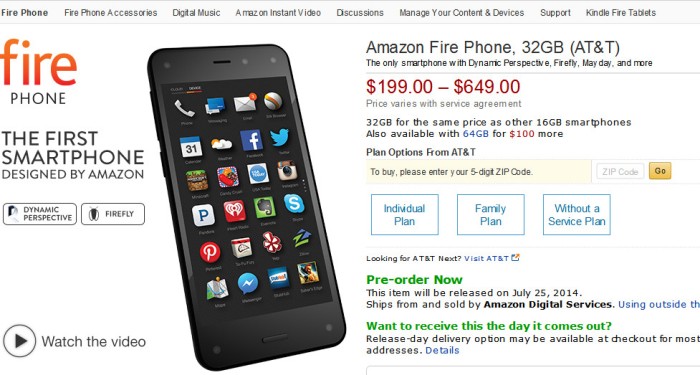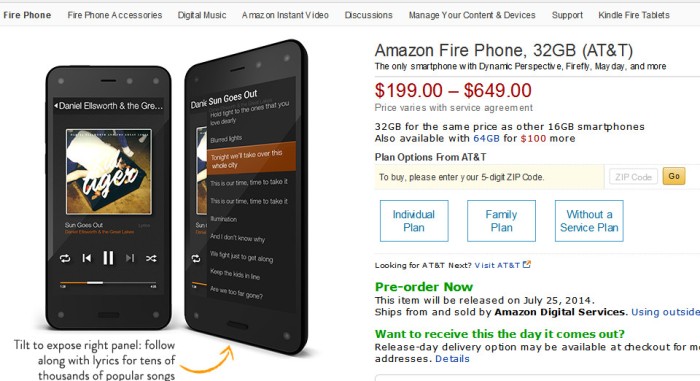Update: Amazon Fire – Gimmicky 3D, Unimpressive Specs, Disappointing Price
Our previous post about the rumored smartphone from Amazon had scarce and unsure details regarding the specs and features. Now, as Amazon officially unveils Amazon Fire, the first ever smartphone from the online retail giant, we can now scrutinize all the accurate details. They seem uninspiring, though.
We were right and wrong. Yes, there’s the 3D tech that tries to differentiate the device from other droids in a market dominated by Samsung. No, the pricing is unexpected. It’s not as cheap as anticipated. Looks like Amazon Fire is indeed bigger and hotter to handle than a Kindle.
The Real Specs
Amazon Fire is an 4G Android smartphone with a quad core Qualcomm Snapdragon 800 8974 processor running at 2200 MHz. This, as nitpickers would say, is last year’s processor for flagship devices. The newer version is the Snapdragon 801 that comes with the Galaxy S5, Xperia Z2, and HTC One M8. Also, devices bearing the Snapdragon 805 are expected to be launched in the second half of this year.
The device is equipped with an Adreno 330 GPU and comes with 2GB of RAM. Its built-storage is a generous 64GB (32GB version also available) but it lacks a microSD slot for storage expansion.
The display is a 4.7” IPS LCD panel with a 720p resolution or a 315 ppi pixel density. It is a multi-touch screen capable of showing 16 million colors and is around as sharp as the Galaxy S3 released two years ago. It is 5 ppi short of Apple’s Retina display resolution and more than 120 ppi lower than the 1080p displays being used by most 1H 2014 flagship devices.
When it comes to the cameras, the rear module of the Amazon Fire is a standard 13MP type with a F2.0 aperture and optical image stabilization. It records 1080p videos at 30 fps. Its internals are comparable to that of the Galaxy Note 3’s so it should be able to take 4K videos but Amazon decided to veer away from the 4K bandwagon. Also, there’s no slow motion capability out of the box. Again, with its hardware, it should be able to do it but Amazon decided to ditch the feature. The front facing camera has a 2.1 MP resolution
In terms of connectivity, the device has the standard fare. It comes with Wi-Fi 802.11 a/b/g/n/ac. It uses the Bluetooth 3.0 EDR standard. It has a microUSB port that uses the USB 2.0 standard and has an NFC radio. Amazon Fire also has GPS, A-GPS, Glonass, Cell ID, as well as Wi-Fi positioning.
The battery is a modest 2400 mAh unit that is not user replaceable. It is rated to last for 22 hours of talk time and 285 hours of standby time, which is rather low.
3D Effect
Of course, there should be some discussion about the hyped 3D effect of the Amazon Fire smartphone. At least this one rumor turned out to be true. With Amazon Fire, the 3D effect is achieved with the help of 4 infrared LEDs and 4 cameras on the front of the device. The purpose of these cameras is to track the location of the device user’s head to display an image that changes according to the supposed perspective of the person viewing the screen, creating a 3D effect on the things shown on the screen. The infrared LEDs are added to make sure that the camera can still track the user’s head even in darkness. At any moment, two of the four cameras are turned on to perform their intended function.
Needless saying, this feature is pure gimmick. It does not add any real useful advantage. While it may create a new user experience, it does not offer anything revolutionary that would make Amazon Fire worth buying. Moreover, with all the NSA snooping or spying issues haunting the users of smartphones, it can be somewhat worrisome having four cameras aimed at your face everytime you use Amazon’s smartphone. Additionally, there’s also the possibility of higher power consumption to continuously run the cameras and infrared LEDs.
Not a Game Changer, Likely to Fail
An article on Forbes points out four main reasons why Amazon Fire could end up becoming a failure. They are as follows:
- Relatively Expensive – With a $650 price tag, Amazon Fire is significantly more expensive than the Nexus 5 and OnePlus One smartphone. It is only $50-$100 cheaper than the Samsung Galaxy S5 and iPhone 5S. The expected Kindle-like pricing didn’t materialize, likely dowsing down any fire the Amazon Fire would like to put up.
- Bulky – With the LG G3 shaving off bezels to accommodate a larger display without making the phone too big, Amazon’s 4.7-incher appears to be an unwinnable effort. It seems to offer a design and form factor that is quite outdated, too big for its screen size.
- Lack of Access to Google’s Core Services – the decision to significantly modify Android has expectedly led to Google’s restrictions. This isn’t going to bode well for Android fans. The apps that can be installed will also be very limited.
- Amazon Fire does not stand out – Despite all the hype about Amazon Fire’s 3D effect, there’s nothing compelling in the handset.
Amazon’s smartphone may help the company create a better experience when buying things at Amazon but it does not offer anything new as a smartphone. It’s even rather ordinary looking. However, only time will tell if Amazon Fire can really become a success. For now,


